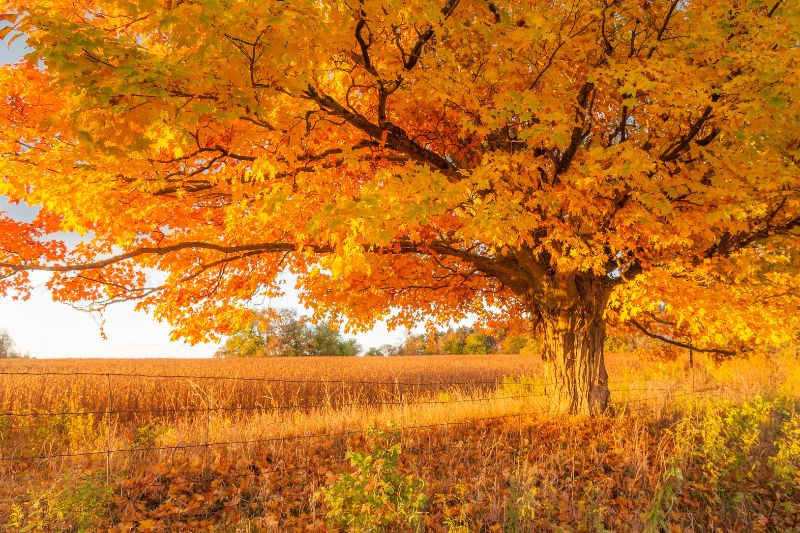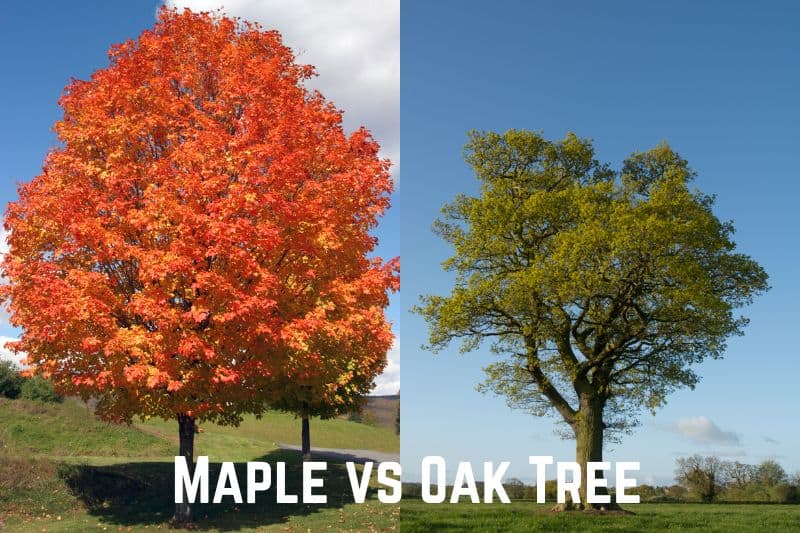Trees such as maples and oaks. What pictures come to mind when you hear these words? Perhaps it’s the thick syrup that goes well with pancakes or the nuts that squirrels love chucking at them. There are notable differences between oak and maple trees despite their seeming similarity in scale and foliage.
There are many things to consider when choosing a tree to plant. Oak and maple trees are two of the most often selected varieties. Each can be the best option in certain circumstances due to their distinct advantages. To assist you in choosing the best kind of tree for your needs, let’s examine some of the main distinctions between these two varieties.

What are Maple Trees?
Acer trees, or maple trees, are a kind of deciduous tree in the genus Acer. This tree, found in North America, Asia, and Europe, represents fortitude, longevity, and knowledge. The maple leaf motif is prevalent in national symbols, literature, and art.
The most reliable way to identify a maple tree is to look at its leaves. These leaves have three and nine lobes; some have prominent veins called petioles. Also, many of these leaves have serrated lobes.
In the fall, the leaves of maple trees change color to Orange, burgundy, yellow, and red. Occasionally, a single tree can have all of these colors together! As a result, the tree is quite the sight with its contrasted colors.
Throughout the summer and once they reappear in the spring, maple trees’ leaves have a deep green hue. They bear fruit that resemble winged seeds. Helicopter seeds are another name for these. Even these seeds are a mystery to some extent.
Samaras, which resemble nuts, are edible fruits. Unlike acorns, they can be harvested directly from the tree and taste better that way. The tree discharges acorns organically.
Lastly, the ability of maple trees to produce sap serves as a clear identifying cue. This sap is highly significant since it is the primary ingredient in maple syrup. Although the sap is delicious when made into maple syrup, it could be unfavorable in its raw form. This is why you may need to choose if the sap will be a good or bad element in your garden, depending on your demands.

What are Oak Trees?
For good cause, oak trees represent the ultimate representation of sturdiness and strength. They can reach 100 feet and live for over a century. There are more than 600 species of oak trees, all indigenous to the northern hemisphere.
Beech and chestnut trees are linked to oaks, which are huge, long-lived vegetation in the genus Quercus. These recognizable trees have been an integral part of British landscape and culture for many years. Oak was prized for its sturdy wood, which was historically used to make furniture, houses, and ships.
The first step in identifying an oak tree is to see if any leaves are present. Anticipate deeply lobed leaves that can have rounded or pointed points. The branches covered with leaves may be too high, or if it’s winter, you won’t get a good view of the leaves. Thus, if the leaves are hidden, focus on the bark!
The oak bark is supposed to look scaly due to the ridges and deep fissures along the trunk. If the tree is very young, the bark could appear smooth. In this scenario, the tree will be shorter overall and have a shorter box. This does not mean it can’t be an oak tree; instead, it just means it has not fully formed yet.
The bark might be black, but it may also have a light silver tone. Therefore, knowing the bark’s hue would not be as helpful in this case. It is more common to refer to an oak tree’s fruit—especially the acorn—as a nut. If cooked correctly, humans can consume these nuts similarly to any other nut!
These essential characteristics can distinguish oak trees. In most cases, we identify and contrast trees by comparing these characteristics with those of other trees. You can determine which tree is better for you by using these.
Differences Between Oak and Maple Trees
Generally speaking, we identify oak and maple trees through their leaves. The tips of the leaves on red oak trees tend to be slightly more pointed than those on white oak trees, which often have rounded tips. The pinnate, veined leaves of maple trees are composed of three individual leaves that combine to form one colossal leaf.
Hardness
Both oak and maple are members of the hardwood family, yet the bark of maple is somewhat more complicated than that of oak. Oak bark is a more stable wood for furnishings that call for thinly cut wood sheets than maple. Products like flooring and formica sheets for furniture may be among them.
Bark Shade
The hue of hard maple typically seems lighter and more uniform across the main body and branches. On the other hand, soft maple is usually deeper, blending in hints of red, brown, and occasionally even gray.
Mature oak trees will exhibit a shift in the shade of their bark, but young oak trees frequently have a silvery brown appearance. Naturally, this varies from species to species, but the bark can turn a pale gray color in certain white oak kinds. Conversely, red oak cultivars can occasionally take on an extremely dark hue that almost looks black.
Leave Shape
Red oak leaves have sharp points, while white oak leaves are frequently rounder. Similarly, a white oak’s lobe is spherical and devoid of bristles at the tip. This suggests that the outer margin serrations on white oak leaves are likewise rounded.
In contrast, the pinnate leaves of a maple tree are made up of three smaller leaves that come together to produce the giant leaf we see. Each leaf is twisted but not perfectly, resembling the leaves of a white oak but not quite.
Size
Maple trees are available in a far greater range of sizes than oak trees. Most maples grow to 10-45 meters, or around 35-150 feet. More giant oak trees can reach heights of 30 meters or 100 feet, while smaller oak trees can reach heights of 6 to 9 meters or 20 to 30 feet. Oak trees are known for something different, while maple trees have the broadest range of growth.
Bark Texture
A young red maple’s smooth, unbroken bark differs from the coarser, cracked bark of, say, a northern red oak. The scarlet oak would be in the middle, resembling a juvenile red maple more than a north red oak due to its typically smooth bark that contains some vertical cracks and seams.
Young oak trees typically have smooth bark, though this might not be true for all kinds. As these trees mature, their bark will become increasingly cracked, with deep ridges running throughout it. On the other hand, maple trees at the same age would typically have comparatively smoother bark.
Do Oak or Maple Trees Grow Faster?
Different factors, such as species, soil quality, location, and environmental circumstances, affect the growth pace of oak and maple trees. On the other hand, maple trees generally grow more quickly in their initial stages than oak trees.
In their early development phases, maple trees, particularly varieties like the red maple and silver maple, are noted for their comparatively quick growth rates. When conditions are right, they can grow many feet a year.
Conversely, oak trees, such as red and white oak, usually grow more slowly, particularly during their early years. Though they frequently grow more slowly than maples, particularly throughout the first few decades, oaks are renowned for their lifespan and can eventually reach astounding sizes.
Are Oak Trees Bigger Than Maple?
Compared to oaks, maple trees can reach a broader range of sizes. Maple trees can reach 10 to 45 meters or 35 to 150 feet. Smaller oak trees may develop to a height of 6 to 9 meters, whereas more giant oak trees may grow up to 30 meters. While oaks are thought to have the most varied growth, maple trees may be in first place.
Maple trees can reach heights of less than 10 m, and because of their numerous little trunks that reach the ground, they resemble shrubs more than trees. Certain types of maple trees grow to be shrubs that mature to a height of eight feet. These tiny maples may grow in pots early in their lives due to their small size.
Oak trees grow both horizontally and vertically. Oak trees are prone to develop far from the center, from the roots to the topmost branch. Among similarly sized maple trees, this kind of growth is rare. If you wish to grow a tall maple tree on a tiny piece of land, remember this.
Conclusion
Since trees offer shade, fresh air, and a habitat for various creatures, they are both aesthetically pleasing and environmentally beneficial. But not every tree is made equally. Two of the most common trees in any neighborhood or forest are oak and maple trees. Maple and oak trees are aesthetically pleasing and vital to the ecosystem.
They have a lot in common despite minor differences in appearance. Which tree is better for your landscape will depend on several factors, including climate, cost, and personal taste. Whichever tree you choose to plant, it will make a distinctive and priceless contribution to your neighborhood or garden.






